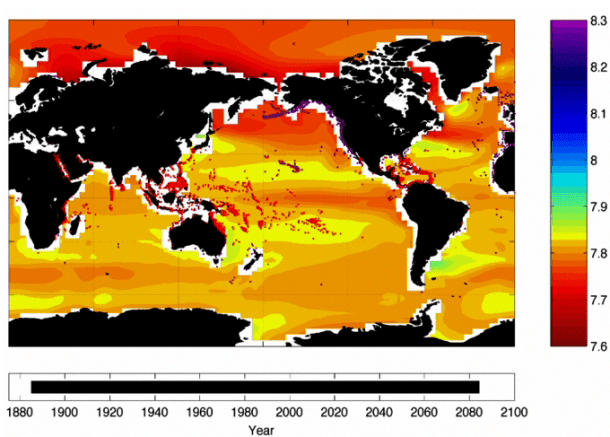
A newly published paper in the journal Science provides a worrisome report – the world’s oceans are acidifying at a rate, which if set to continue, will be unprecedented in the last 300 million years. The scientists report that this comes as a direct consequence of the alarming ever increasing carbon dioxide concentration in the atmosphere, which also gets absorbed by the oceans, with dramatic effects on the marine ecosystem.
To trace back the other periods of accelerated ocean acidification in Earth’s history, the scientists from the U.S. National Oceanic and Atmospheric Administration (NOAA) studied the isotopic composition of carbon changes found in marine rock samples. Rock records dating back as far as 300 million years were studied, which allowed tracking the ocean’s water pH over an impressive time frame. Thus, the researchers identified a number of key periods in Earth’s history when atmospheric CO2 concentration, and thus ocean water pH too, reached milestone levels. These spurred evolutionary changes, as well as marine and animal extinction, like 65 million years ago when the dinosaurs died off.
An interesting period was the Paleocene-Eocene Thermal Maximum (or PETM), dating back 56 million years ago, when an abrupt carbon dioxide release caused a global temperature increase of 6°C over 20,000 years. During PETM, the oceans became 0.4 units more acidic on the 14-point pH scale. This period marked the largest deep-sea extinction of foraminifera of the last 75 million years, and was one of the four biggest coral reef disasters of the last 300 million years. The study authors warn that what happened 56 million years ago was a fast warm-up and quick acidification, however when compared with the current rate of CO2 levels increase and water acidification since the start of the industrial age 150 years ago, we’re currently on a trend that will far out shadow it.
Climate change comes in cycles, warming and cooling, and the Earth has gone through a number of such periods during its history. It’s enough to compare some charts and time frames for relevancy to understand that there’s nothing really natural to what’s going on today on our planet, however. For instance, the first period the NOAA scientists decided to study was the end of the last ice, which started 18,000 years ago. Over a period of about 6,000 years, atmospheric CO2 levels increased by 30 percent, translating in a change of roughly 75 ppm – the same amount of increase was recorded in the past 50 years alone!
“Ocean acidification may have severe consequences for marine ecosystems,” reads the study. “However, assessing its future impact is difficult because laboratory experiments and field observations are limited by their reduced ecologic complexity and sample period.”
A similar report such as the from NOAA, was presented last summer at an U.N. conference. Then, the panel found that oceanic conditions are similar to those of “previous major extinctions of species in Earth’s history,” and that we face losing marine species and entire marine ecosystems, such as coral reefs, within a single generation.
Over the past 150 years, the Earth’s oceans have become more acidic by 0.1 unit of pH, and the study’s scientists predict that by 2100 there will be an increase to 0.2 or 0.3 pH.
“Given that the rate of change was an order of magnitude smaller compared to what we’re doing today, and still there were these big ecosystem changes, that gives us concern for what is going to happen in the future,” said Baerbel Hoenisch, one of the study’s lead authors.






